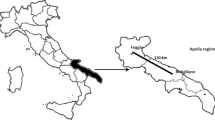Summary
Measurements were made at New Delhi (India) on wheat (Triticum aestivum L.) and mungbean (Vigna radiata L.) crops growing during the winter and summer seasons respectively, to evaluate the use of the equation of Bartholic, Namken and Wiegand (1970) for estimating daytime evapotranspiration from a single measured canopy temperature. Measurements on eleven days indicated that a single observation of the canopy temperature taken at any time between noon and 2 p.m. could be used to compute daytime evapotranspiration with an error (underestimate) of less than 27% as compared with values measured by the Bowen ratio method. The regression equation ET0 = 0.618 + 0.96 ET1 has a coefficient of determination of 0.927 and can be used to relate daytime evapotranspiration by the Bowen ratio method (ET0) to that estimated by the Bartholic-Namken-Wiegand equation (ET1) for wheat and mung bean crops grown under adequately watered conditions in the New Delhi region.
Similar content being viewed by others
References
Bartholic JP, Namken LR, Wiegand CL (1970) Combination equation used to calculate evaporation and potential evaporation. USDA-ARS-Bull 41-170: 14 pp
Brown KW, Rosenberg NJ (1972) A resistance model to predict evapotranspiration and its application to a sugar beat field. University of Nebraska, Lincoln. Horticulture Prog Rep 25:51–5.31
Campbell AP (1973) The effect of stability on evaporation rates measured by energy balance method. Agric Meteorol 11:261
Fuchs M, Tanner CB (1970) Error analysis of Bowen ratio measured by differential psychrometry. Agric Meteorol 7:329
Gupta PL, Sastry PSN (1984) Remotely sensed canopy temperature based models for estimating evapotranspiration. Proceedings of fifth Asian conference on remote sensing, Kathmandu (Nepal), pp P7.1
Jackson RD, Reginato RJ, Idso SB (1977) Wheat canopy temperature: A practical tool for evaluating water requirements. Water Resour Res 13:651
Nkemdirim LC, Yamashita S (1972) Energy balance over prairie gras. Can J Plant Sci 52:215
Reimer A, Desmarais R (1973) Micrometeorological energy budget methods and apparent difficulty for Boreal forest and grass sites at Pinawa, Minitiba, Canada. Agric Meteorol 11:419
Saha SK, Ajay, Kamat DS, Singh AK, Aggarwal PK, Chaturvedi GS, Sinha SK (1984) Remote sensing of crop evapotranspiration using plant canopy temperature. Proceedings of Seminar on crop growth condition and remote sensing, Indian Agricultural Research Institute, New Delhi, pp 5.1.2–5
Seguin B, Itier B (1983) Using midday surface temperature to estimate daily evaporation from the satellite thermal IR data. Int Remote Sensing J 4:371
Stone LR, Horton ML (1974) Estimating evapotranspiration using canopy temperatures. Field evaluation. Agron J 66:450
Author information
Authors and Affiliations
Rights and permissions
About this article
Cite this article
Gupta, P.L., Sastry, P.S.N. Estimating evapotranspiration from midday canopy temperature. Irrig Sci 7, 237–243 (1986). https://doi.org/10.1007/BF00270433
Received:
Issue Date:
DOI: https://doi.org/10.1007/BF00270433




